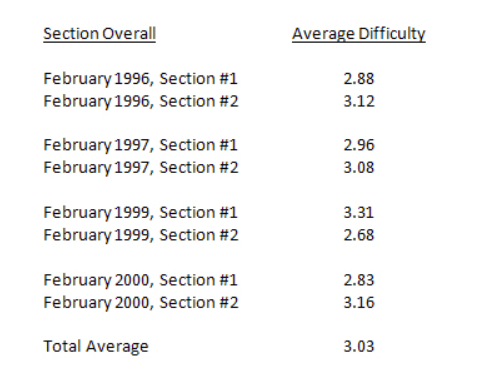So far in this mini series, we have covered Question-by-Question Difficulty and Individual Question Difficulty. These have largely covered the individual questions within a section on Logical Reasoning on the LSAT. In this post, I am focusing my efforts to discuss overall difficulty in the LR section. Following that, I’ll address how that figures into the creation of an LSAT.
Overall Difficulty by the Numbers
For this, we are using the statistics cited in my previous posts. From there, we have a composite of the overall average difficulty of each section from the four tests under discussion.
Thus, although the typical section does vary in overall difficulty, the average hovers around level 3 (medium difficulty). Furthermore, when a section is unusually easy or hard, the other section offsets the difficulty and acts as a counterbalance. For an example, refer to the February 1999 section numbers above. That test is a perfect demonstration of how section difficulty is balanced.
Overall, this is not surprising. The makers of the LSAT scale each test to an overall level of difficulty. It does not work on individual section level of difficulty. So, on individual LSATs, some sections are harder than others. But, when compiled, they match the same overall level of difficulty from test to test. Or, at least, that’s the goal of the test makers. With that being said, it is inevitable that there will be variances in overall difficulty. They use the scoring scale to adjust the picture so the final results are the same from test to test.
So What Does This Mean?
Here’s what you should take away from this information. If you encounter an especially difficult section on the LSAT, you’ll likely encounter a relatively easier one elsewhere. Thus, do not get discouraged if you run into a troublesome patch on the LSAT! Chances are an easier section will be around the corner.



Rain says
Thank you just read.